Cabbage is a popular cultivar of the Brassica family, also known as Brassica Oleracea Capitata. It is used in the USA as a hardy and green leafy vegetable. It is available in various shades of purple, red and green colors. If you live in a location with a climate suitable for Cabbage, read everything you need to know about growing this delicious and healthy vegetable.
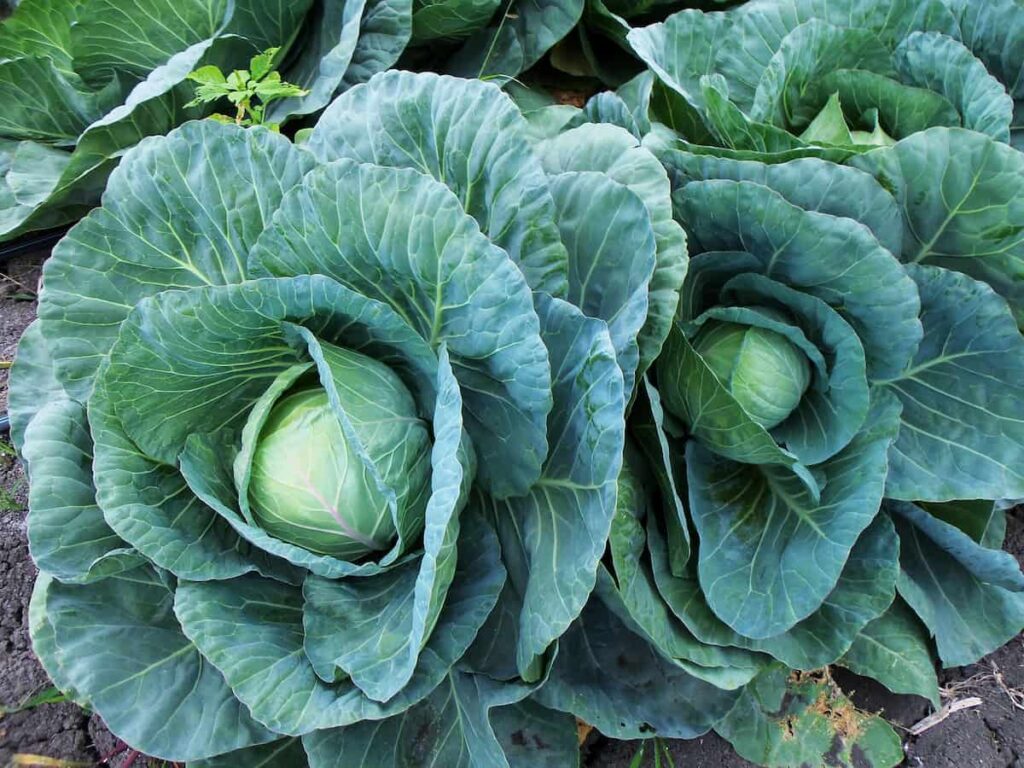
How to grow Cabbage in the USA
Soil requirement for growing Cabbage in the USA
- The Cabbage plant is a cool-weather crop that grows best in well-drained and fertile soil with a pH between 6.0 and 7.0. Add organic matter to your soil before planting to improve drainage and fertility.
- Cabbage’s best type of soil is a mix of sandy and clay soils. This type of soil drains well and holds nutrients, making it ideal for growing Cabbage.
- When choosing a location for your Cabbage plants, ensure the area has good drainage. If the area doesn’t drain well, the roots of your plants will be sitting in waterlogged soil, which can lead to root rot.
- To prepare the soil for planting, mix in some compost or aged manure to help improve drainage and add nutrients. If you have sandy soil, you may also need to add some organic matter to help retain moisture.
Cabbage growing areas in the USA
- It is a cool-weather crop and can be grown in most parts of the USA. However, some areas are better suited for Cabbage production than others. The best Cabbage-growing areas in the United States are the Northeast, the Northwest, and the Upper Midwest. These regions have cool summers and winters, ideal for Cabbage growth.
- Although Cabbage is grown throughout the United States, 78 percent of the nation’s total Cabbage (fresh market and processing) is produced in five states, California, Wisconsin, New York, Florida, and Texas.
- The USA is one of the world’s top Cabbage producing countries. The United States produced over 8.5 million metric tons of Cabbage. Most Cabbage production in the United States occurs in California, Florida, and Arizona.
- Northeast: The Northeast is one of the best regions for growing Cabbage in the United States. This region has cool summers and winters, ideal for Cabbage growth.
- Northwest: The Northwest is another excellent region for growing Cabbage in the United States. This region has cool summers and mild winters, ideal for Cabbage growth.
- Upper Midwest: The Upper Midwest region is also an excellent area for growing Cabbage in the United States. This region has cool summers and cold winters, ideal for Cabbage growth. Cabbage can be planted in early spring and harvested from mid-fall to early winter in this region.
In case you missed it: Cabbage Farming; Planting; Care; Harvesting
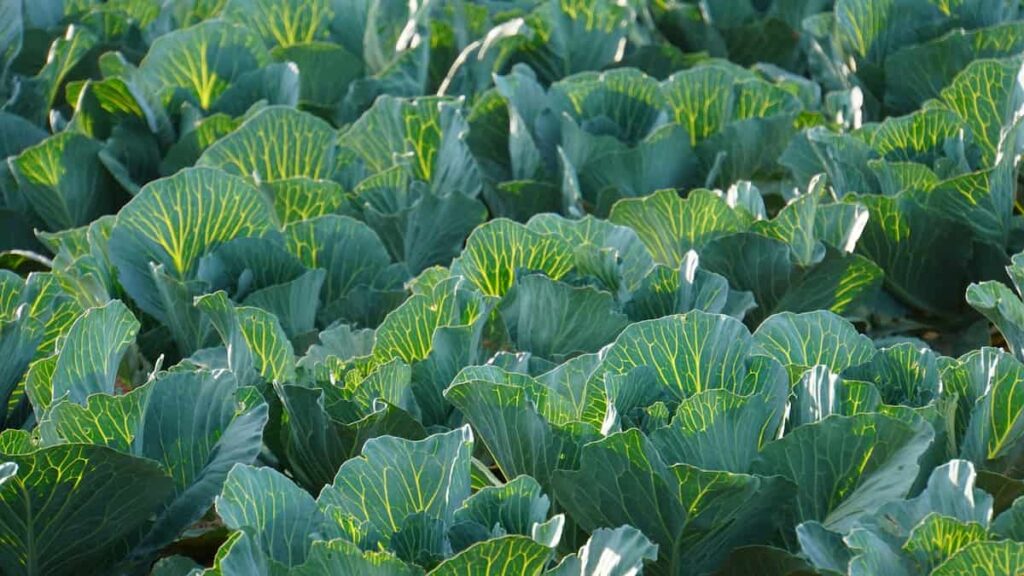
Cabbage growing conditions in the USA
- Cabbage (Brassica oleracea) is a cool-weather crop that thrives in well-drained, fertile soil with pH levels of 6.0 to 7.0. In the United States, Cabbage is typically planted in late winter or early spring and harvested in late spring or early summer.
- Choosing a planting site with full sun and rich, loose soil is essential to ensure a bountiful harvest. The ideal soil temperature for Cabbage seeds is 21°C.
- Water newly planted Cabbage regularly, so the soil stays evenly moist but not soggy. Mulching around the plants will help conserve moisture and keep down weeds.
Cabbage production in California
- California produces a large percentage of the country’s supply. The state’s climate and soil are well-suited to Cabbage production, and many farmers have successfully grown this vegetable.
- Cabbage prefers cool weather and does best when planted in early spring or fall. However, cabbage can be planted in California as early as February and November.
Cabbage varieties in the USA
Many different types of Cabbage can be grown in the USA. Some of the most popular varieties include:
- Green Cabbage: This is the most common type of Cabbage and can be found in most grocery stores. It has a firm texture and a slightly sweet flavor.
- Red Cabbage: This variety has a deep purple color and a slightly sharper flavor than green Cabbage. It is often used in salads or as a garnish.
- Savoy Cabbage: This variety has wrinkled, dark green leaves and a milder flavor than other types of Cabbage. It is often used in soups or stews.
- Napa Cabbage: Also known as Chinese Cabbage, this type has long, thin leaves and a mild, crunchy texture. It is often used in stir-fries or as an ingredient in salads.
In case you missed it: Cabbage Cultivation Income; Cost; Profit; Project Report
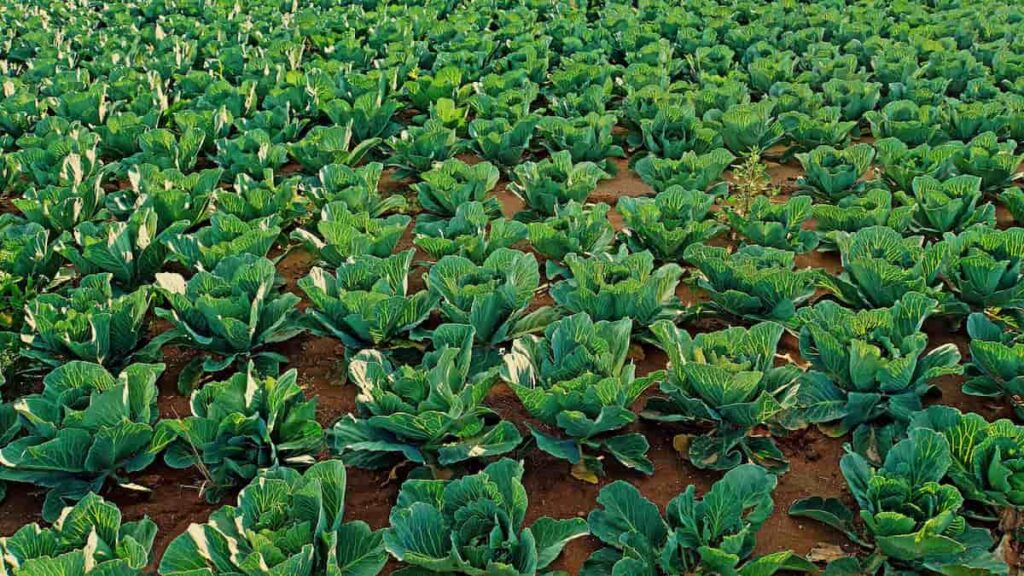
Steps to grow Cabbage in containers in the USA
If you love Cabbage but don’t have the space for a garden, you can grow this tasty vegetable in containers. Here are the steps to growing Cabbage in containers in the USA:
- Choose the right container for growing Cabbage. Cabbage plants have deep roots, so you’ll need a deep pot or planter. A 12-inch pot is ideal.
- Fill your container with a high-quality potting mix or compost. Cabbage loves rich, fertile soil.
- Sow seeds or transplants (Starter plants already a few inches tall). If you’re starting with seeds, sow them about 1/4 inch deep and keep them moist until they germinate. Transplants can be planted directly into the soil at the same depth as they were growing in their original pots.
- Thin seedlings to about 10 inches apart when they are 4-6 inches tall. This will give them room to grow and produce large heads of Cabbage.
- Water regularly, keeping the soil moist but not soggy (Cabbage doesn’t like “wet feet”). Mulch around your Cabbage plants to help retain moisture.
- Fertilize with a balanced liquid fertilizer or compost tea every few weeks to keep your plants healthy and productive.
Step-by-step process to grow Cabbage from seeds in the USA
- If you want to learn about growing Cabbage in the USA, you’ve come to the right location.
- Growing Cabbage in the USA is a great way to enjoy fresh, healthy produce all year round. In most parts of the country, it takes about 60 days from planting until harvest.
- To get started, you’ll need some quality seeds. You can find these at your local nursery or garden center or online. Once you have your seeds, you’ll need to prepare them for planting. To do this, soak them in water for 24 hours before sowing.
- Once your Cabbage seeds are prepped and ready to go, it’s time to start planting. If you’re starting your plants indoors, sow them in seedling trays filled with moistened potting mix. Place the trays in a warm location and keep the soil moist. Your seedlings should emerge within 7-10 days. When they reach about 4 inches tall, it’s time to transplant them into larger pots or outdoors.
Cabbage plant care in the USA
Assuming you want tips on how to take care of Cabbage once it is planted:
- Cabbage thrives in full sun and moist, well-drained soil with a neutral pH. If your soil is lacking in nutrients, consider adding some compost or manure before planting.
- Water your Cabbage regularly, especially during hot, dry weather. Keep the soil moist but not waterlogged. Mulching the plant with straw or grass clippings can help retain moisture.
- Cabbage is a cool-weather crop and can tolerate light frost. However, prolonged exposure to freezing temperatures will damage the plants. In regions with cold winters, it is best to plant Cabbage in the spring to mature before winter sets in.
- Keep plants well-watered, especially during hot, dry periods. Mulching around plants will help retain moisture.
- Keep your Cabbage plants clean and debris-free to prevent pests and disease. Remove any yellowing or wilted leaves as soon as you see them. Crop rotation can also help reduce disease risk by preventing pathogens from building up in the soil.
- It is ready to harvest when heads are firm and solid. Cut heads off at the base with a sharp knife.
In case you missed it: Cabbage Pests and Diseases, Control Methods
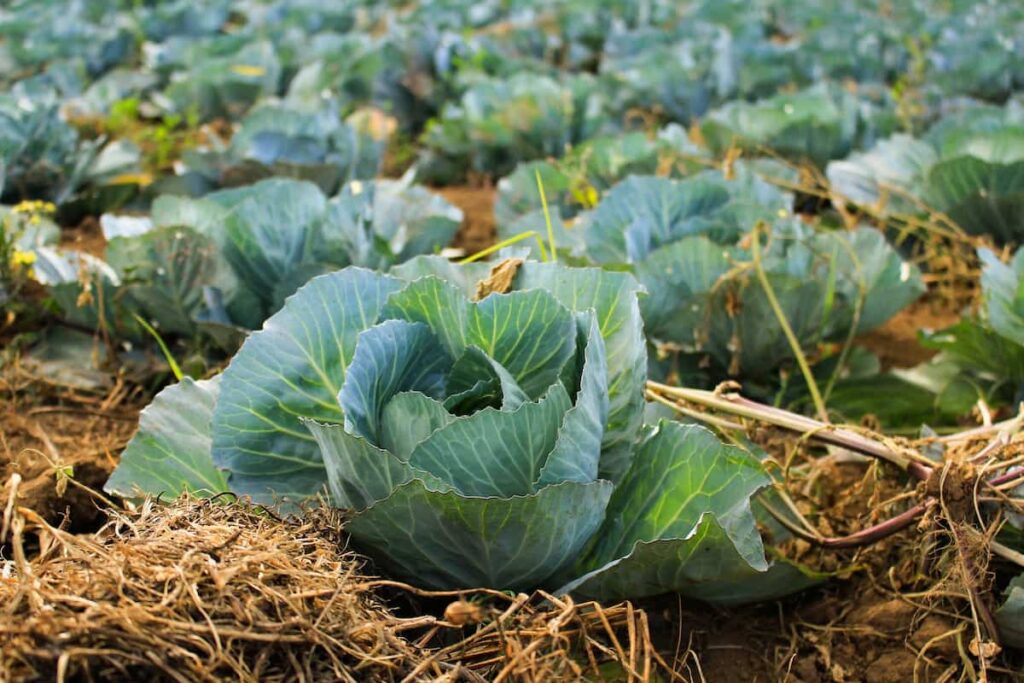
Cabbage fertilizer requirements
- Fertilize your plants every few weeks with a balanced fertilizer to ensure they have all the nutrients they need to grow healthy heads of Cabbage.
- Cabbage is a heavy feeder and benefits from regular fertilizer applications throughout the growing season. For best results, use a balanced fertilizer like 10-10-10 or 8-8-8 at the rate of 1 pound per 100 square feet of garden area. Apply fertilizer when preparing the bed for planting, side dress when plants are 6 to 8 weeks old, and again when heads are forming.
- You can use an organic fertilizer like fish emulsion or compost tea. These must be applied more frequently than chemical fertilizers, so follow the manufacturer’s directions.
- Overfertilization can lead to leafy growth at the expense of head development, so don’t go overboard with the fertilizer.
Water requirement for growing Cabbage
Cabbage requires a lot of water, especially during the hot summer months. Water your Cabbage regularly, keeping the soil moist but not soggy. If the soil dries out, the Cabbage will wilt, and the heads will be small and dry.
Cabbage growing problems in the USA
- Cabbage is a nutritious, leafy vegetable that can be grown in many parts of the United States. While Cabbage is relatively easy to grow, some problems can occur.
- One of the most common problems is nutrient deficiency. Cabbage requires a lot of nitrogen, potassium, and phosphorus to grow properly. If your soil lacks these nutrients, your Cabbage will not grow as well as it could. You can amend your soil with compost or manure to improve its nutrient content.
- Another problem that can occur is pests and diseases. Cabbage is susceptible to various pests and diseases, including caterpillars, aphids, and black rot. To prevent these problems, it’s essential to choose a pest-resistant variety of Cabbage and practice good crop rotation.
- Many problems can occur when growing Cabbage. Cabbage leaves can be susceptible to fungal diseases, such as black rot and downy mildew. These diseases can cause the leaves to turn brown or black, making the plant less productive. Cabbage worms, aphids, and flea beetles can damage the leaves and reduce yields. In addition, Cabbage plants are sometimes affected by nutrient deficiencies, which can cause the leaves to turn wilt or yellow.
- Finally, weather can also cause problems for Cabbage growers. Too much heat or cold can damage Cabbage plants and make them more susceptible to pests and diseases. It’s essential to choose a variety of Cabbage that is well-suited for your climate and to protect plants from extreme weather conditions with row covers or other means.
In case you missed it: Organic Cabbage Farming, Steps, Cultivation Practices
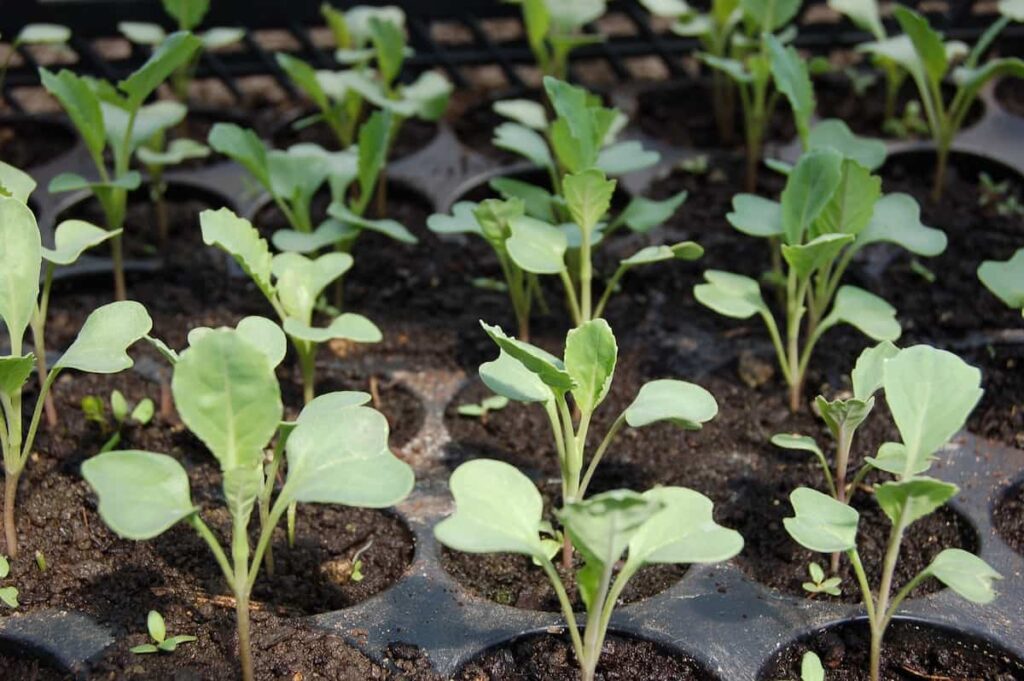
Cabbage yield in the USA
Many factors determine Cabbage yield in the USA. The type of Cabbage, the climate, and the soil all play a role in how much Cabbage a farmer can expect to harvest. Different types of Cabbage have different yields, with some varieties yielding as little as one pound per plant and others yielding up to eight pounds. Most varieties’ average yield falls between two and four pounds per plant.
Climate also plays a role in Cabbage yield. Cabbage prefers cool weather and will not do well in hot and humid conditions. In general, the farther north a farmer is, the higher the Cabbage yield will be. This is because northern climates are cooler than southern climates, which is ideal for Cabbage growth.
Cabbage pests, diseases, and their control in the USA
- Cabbage is susceptible to several pests and diseases, including aphids, caterpillars, clubroot, and downy mildew. It is essential to practice crop rotation and use soil amendments such as lime and compost to control pests and diseases.
- Cabbage is susceptible to various pests and diseases. Some common pests that attack Cabbage include caterpillars, aphids, thrips, whiteflies, and root maggots. Common diseases that affect Cabbage include black rot, downy mildew, Alternaria leaf spot, clubroot, and white rust.
- Pest and disease problems can be minimized by following some simple guidelines. These include choosing disease-resistant varieties, rotating crops annually, keeping the garden clean and free of debris, and watering early in the day. Hence, the leaves have time to dry before nightfall.
- Pests: Aphids, caterpillars, and whiteflies can all damage Cabbage plants. These can be controlled with insecticidal soap or other organic methods.
- Diseases: Cabbage can be affected by several diseases, including black rot, downy mildew, and white mold. These diseases are best controlled by using fungicides and following a regular spraying schedule.
Common Cabbage pests
- Aphids – These small insects suck the sap from Cabbage plants and cause stunted growth or deformities.
- Cabbage loopers – This moth’s larvae feed on Cabbage plants’ leaves, causing them to become ragged and tattered. Loopers are most active in late summer and fall.
- Cutworms – These caterpillars cut off ground-level seedlings and can destroy an entire crop if not controlled. Cutworms are most active in late spring and early summer.
- Bolting: This occurs when the Cabbage plant produces a flower stalk and goes to seed. It is typically caused by warm weather and can be prevented by planting later in the season or using a bolt-resistant variety.
There are several ways to control Cabbage pests, including row covers, traps, and pesticides. Be sure to read all pesticide labels carefully and follow all safety precautions.
Cabbage harvesting tips
The best time to harvest Cabbage is when the heads are firm, and the leaves are green.
- Cut Cabbage heads when they are about 6-8 inches in diameter.
- Use a sharp knife or garden shears to avoid crushing the head.
- Cut the stem at an angle so that rainwater can drain off.
- Harvest early in the morning for the best flavor.
- For longer storage, cut off any outer leaves that are damaged or browning.
In case you missed it: Top 15 Steps to Boost Cabbage Yield: How to Increase Size, Quality, and Production

Frequently asked questions about growing Cabbage in the USA
What climate is best for Cabbage?
Cabbage likes cool and moist climates.
Is Cabbage hard to grow?
Easy to grow, nutritious, and tasty, Cabbages are veg plot favorites. There are many different types, in various shapes, sizes, and colors, for harvesting at all times of the year.
How many Cabbages will one plant produce?
The plant will send up as many as 6 new heads – harvest when about tennis ball size. Begin harvesting leaf Cabbage about a month after planting and harvest the outer leaves using the cut-and-come-again method.
Does Cabbage regrow after cutting?
Most types of Cabbage, if you do cut off the bottoms to regrow again, will sprout out some fresh leaves. Similar to lettuce, you can plant the Cabbage once roots appear.
What makes Cabbage grow faster?
Cabbage needs nutrient-rich soil to grow and maximize production and yields. Some Cabbage farmers apply well-rotted manure and plow the soil two weeks before planting. They also report that they can add fertilizer to the young seedlings about two weeks or three weeks after transplant.
Conclusion
Cabbage is a Brassica family member, including broccoli, Brussels sprouts, and kale. It is a cool-weather crop that does best in regions with long winters and cool summers. With the proper care, Cabbage can be a bountiful addition to any home garden.
- Economical Aquaculture: A Guide to Low-Budget Fish Farming
- 15 Common Planting Errors That Can Doom Your Fruit Trees
- How to Make Houseplants Bushy: Effective Tips and Ideas
- Innovative Strategies for Boosting Coconut Pollination and Yield
- Pollination Strategies for Maximum Pumpkin Yield
- The Complete Guide to Chicken Fattening: Strategies for Maximum Growth
- Natural Solutions for Tulip Problems: 100% Effective Remedies for Leaf and Bulb-Related Issues
- Revolutionizing Citrus Preservation: Towards a Healthier, Greener Future
- Natural Solutions for Peony Leaf and Flower Problems: 100% Effective Remedies
- Maximizing Profits with Avocado Contract Farming in India: A Comprehensive Guide
- Natural Solutions for Hydrangea Problems: 100% Effective Remedies for Leaf and Flowers
- The Ultimate Guide to Choosing the Perfect Foliage Friend: Bringing Life Indoors
- From Sunlight to Sustainability: 15 Ways to Use Solar Technology in Agriculture
- The Ultimate Guide to Dong Tao Chicken: Exploring from History to Raising
- The Eco-Friendly Makeover: How to Convert Your Unused Swimming Pool into a Fish Pond
- Mastering the Art of Delaware Chicken Farming: Essentials for Healthy Backyard Flocks
- 20 Best Homemade Fertilizers for Money Plant: DIY Recipes and Application Methods
- How to Craft a Comprehensive Free-Range Chicken Farming Business Plan
- Brighten Your Flock: Raising Easter Egger Chickens for Beauty and Bounty
- How to Optimize Your Poultry Egg Farm Business Plan with These Strategies
- Subsidy for Spirulina Cultivation: How Indian Government Schemes Encouraging Spirulina Farmers
- Ultimate Guide to Raising Dominique Chickens: Breeding, Feeding, Egg-Production, and Care
- Mastering the Art of Raising Jersey Giant Chickens: Care, Feeding, and More
- Ultimate Guide to Raising Legbar Chickens: Breeding, Farming Practices, Diet, Egg-Production
- How to Raise Welsummer Chickens: A Comprehensive Guide for Beginners
- How to Protect Indoor Plants in Winter: A Comprehensive Guide
- Ultimate Guide to Grow Bag Gardening: Tips, Tricks, and Planting Ideas for Urban Gardeners
- Guide to Lotus Cultivation: How to Propagate, Plant, Grow, Care, Cost, and Profit
- Agriculture Drone Subsidy Scheme: Government Kisan Subsidy, License, and How to Apply Online
- Ultimate Guide to Raising Araucana Chickens: Breed Profile, Farming Economics, Diet, and Care
- Bringing Hydroponics to Classroom: Importance, Benefits of Learning for School Students
- Ultimate Guide to Raising Polish Chickens: Breed Profile, Farming Economics, Diet, and Care
- Ultimate Guide to Raising Australorp Chickens: Profile, Farming Economics, Egg Production, Diet, and Care
- Silkie Chicken Farming: Raising Practices, Varieties, Egg Production, Diet, and Care
- Sussex Chicken Farming: Raising Practices, Varieties, Egg Production, Diet and Care
- Homemade Feed Formulations for Livestock: Discover Cost-effective Starter to Finisher Feed Recipes